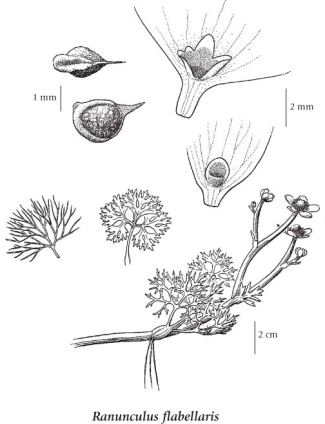Ranunculus flabellaris Raf.
yellow water-buttercup (yellow water buttercup; yellow water-crowfoot)
Ranunculaceae (Buttercup family)
Introduction to Vascular Plants
yellow water-buttercup (yellow water buttercup; yellow water-crowfoot)
Ranunculaceae (Buttercup family)
Introduction to Vascular Plants
Species Information
General:
Aquatic to amphibious, perennial herb, rooting from nodes of lower stems, roots fibrous, slender; stems coarse, freely-branched, floating or creeping, smooth, hollow.
Leaves:
Basal leaves rarely present; submerged stem leaves alternate, semicircular to kidney-shaped, 1-7 cm long, 2-11 cm wide, 1- to 6-times parted, lobed, or dissected, the segments entire or round-toothed, tips rounded to thread-like; floating stem leaves absent or unlike submerged, 3-lobed, lobes linear to oblong; stalks 0.5-4 cm long.
Flowers:
Inflorescence of 1- to few-flowered terminal and axillary cymes, on stout stalks to 10 cm long; receptacle sparsely stiff-hairy; petals 5-6, distinct, yellow, 7-12 mm long, 5-9 mm wide, nectary on upper surface, the nectary scale variable, 1.5 mm long; sepals 5, spreading or weakly bent back, early deciduous, 5-7 mm long, 3-6 mm wide, smooth; stamens 30-70; pistils 30-70.
Fruits:
Achenes, numerous in an egg-shaped head 8-10 mm long, 7-8 mm wide, the achenes egg-shaped, flattened, 1.8-2.2 mm long, 1.6-2.2 mm wide, smooth; beaks persistent, lanceolate, flattened, straight or somewhat curved at tip, 1-1.8 mm long.
Notes:
This species is closely related to R. gmelinii.
Illustration

If more than one illustration is available for a species (e.g., separate illustrations were provided for two subspecies) then links to the separate images will be provided below. Note that individual subspecies or varietal illustrations are not always available.
Illustration Source: The Illustrated Flora of British Columbia
Ecology
Ecological Framework for Ranunculus flabellaris
The table below shows the species-specific information calculated from
original data (BEC database) provided by the BC Ministry of Forests and Range.
(Updated August, 2013)
The table below shows the species-specific information calculated from
original data (BEC database) provided by the BC Ministry of Forests and Range.
(Updated August, 2013)
| Site Information |
Value / Class |
||
|
Avg |
Min |
Max |
|
| Elevation
(metres) |
864 | 7 | 2249 |
| Slope
Gradient (%) |
2 | 0 | 43 |
|
Aspect (degrees) |
120 | 0 | 160 |
| Soil
Moisture Regime (SMR) [0 - very xeric; 4 - mesic; 8 - hydric] |
6 | 2 | 8 |
| Modal
Nutrient Regime
Class |
C | ||
| #
of field plots species was recorded in: |
44 | ||
| Modal
BEC Zone Class |
IDF | ||
|
All BEC Zones (# of stations/zone) species was recorded in |
BG(1), CWH(8), ESSF(1), ICH(2), IDF(14), IMA(1), MS(6), PP(1), SBPS(1), SBS(6) | ||
|
Source:
Klinkenberg 2013
|
|||
Habitat and Range
Ponds and shorelines in the steppe, montane and subalpine zones; infrequent and scattered in S BC east of the Coast-Cascade Mountains; E to PQ and NB and S to KS, NC, LA, UT, NV and N CA.Status Information
Synonyms
Synonyms and Alternate Names:
Ranunculus delphiniifolius Torr. ex Eat.